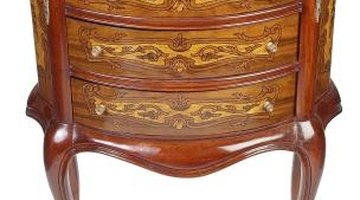How to Repair Scratches on a Polyurethane Finish
Scratched polyurethane surfaces are easily repaired as long as there is a deep enough layer of polyurethane protecting the furniture. Scratches that gouge deeply into the wood's surface require significant repair that should not be attempted by an inexperienced woodworker. Light, repairable scratches appear to be slight indentations in the surface of the wood. The polyurethane will not appear to have been cracked, and the wood underneath will be untouched.

-
Wrap the 800-grit sandpaper around the sanding block tightly, then sand the surface of the polyurethane finish. Avoid using a circular motion. Instead, create the pattern of an "X." Continue sanding until the scratch is level with the surface of the surrounding polyurethane, but be careful to avoid sanding through the polyurethane into the wood beneath.
-
Remove the 800-grit sandpaper from the sanding block and replace it with the 1500-grit sandpaper. This paper is not intended to remove the scratch, but to minimize the scratches left by the 800-grit sandpaper. Continue sanding with the 1500-grit sandpaper until the surface is uniformly smooth.
-
Apply a small amount of the rubbing compound to a clean cloth and gently rub the sanded surface. The polishing compound has a grit equivalent to approximately 3000-grit sandpaper, so it will remove the 1500-grit scratches and polish the surface of the polyurethane.
-
Wipe the excess polishing compound off the polyurethane finish to complete the scratch removal.
References
- "Furniture Repair & Restoration"; Brian Hingley; 2010
- "The Practical Illustrated Guide to Furniture Repair and Restoration"; Billy Cook; 2010
- "The Furniture Doctor"; George Grotz; 1989
Tips
- Wipe the surface after the repair with a high-quality furniture polish to protect the finish.
Writer Bio
Don Kress began writing professionally in 2006, specializing in automotive technology for various websites. An Automotive Service Excellence (ASE) certified technician since 2003, he has worked as a painter and currently owns his own automotive service business in Georgia. Kress attended the University of Akron, Ohio, earning an associate degree in business management in 2000.
Photo Credits
- Hemera Technologies/PhotoObjects.net/Getty Images
More Articles



